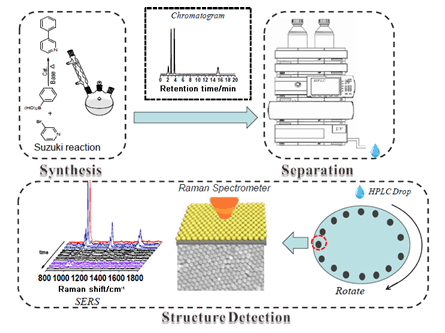| [1] Booth, S. L.; Davidson, K. W.; Sadowski, J. A. J. Agric. Food. Chem. 1994, 42, 295.
[2] Liu, X. S.; Wu, Z. Z.; Yang, K.; Ding, H. Y.; Wu, Y. J. J. Pharmaceut. Biomed. 2013, 76, 70.
[3] Wagner, K.; Miliotis, T.; Marko-Varga, G.; Bischoff, R.; Unger, K. K. Anal. Chem. 2002, 74, 809.
[4] Tang, A. N.; Jiang, D. Q.; Jiang, Y.; Wang, S. W.; Yan, X. P. J. Chromatogr. A 2004, 1036, 183.
[5] Tomas-Barberan, F. A.; Gil, M. I.; Cremin, P.; Waterhouse, A. L.; Hess-Pierce, B.; Kader, A. A. J. Agric. Food. Chem. 2001, 49, 4748.
[6] Cowcher, D. P.; Jarvis, R.; Goodacre, R. Anal. Chem. 2014, 86, 9977.
[7] Jemal, M. Biomed. Chromatogr. 2000, 14, 422.
[8] Su, D.; Chan, C. T. Y.; Gu, C.; Lim, K. S.; Chionh, Y. H.; McBee, M. E.; Russell, B. S.; Babu, I. R.; Begley, T. J.; Dedon, P. C. Nat. Protoc. 2014, 9, 828.
[9] Ebdon, L.; Hill, S.; Ward, R. W. Analyst 1986, 111, 1113.
[10] Zhao, H.; Hasi, W.; Bao, L.; Han, S.; Sha, X. Y.; Sun, J.; Lou, X. T.; Lin, D. Y.; Lv, Z. W. Chin. J. Chem. 2017, 35, 1522.
[11] Gao, Z. G.; Zheng, T. T.; Deng, J.; Li, X. R.; Qu, Y. Y.; Lu, Y.; Liu, T. J.; Luo, Y.; Zhao, W. J.; Lin, B. C. Acta Chim. Sinica 2017, 75, 355. (高志刚, 郑婷婷, 邓九, 李晓瑞, 曲玥阳, 陆瑶, 刘婷娇, 罗勇, 赵伟杰, 林炳承, 化学学报, 2017, 75, 355.)
[12] Su, Y.; Peng, T.; Xing, F.; Li, D.; Fan, C. Acta Chim. Sinica 2017, 75, 1036. (苏莹莹, 彭天欢, 邢菲菲, 李迪, 樊春海, 化学学报, 2017, 75, 1036.)
[13] Leng, C. B.; Wang, C.; Xiu, H. X.; Qu, X. M.; Chen, L. Z.; Tang, Q.; Li, L. Chin. J. Chem. 2016, 34, 273.
[14] Fan, W.; Yue-E, M.; Ling, X.; Liu, T. Chin. J. Chem. 2016, 34, 73.
[15] Cabalin, L. M.; Ruperez, A.; Laserna, J. J. Talanta 1993, 40, 1741.
[16] Sagmuller, B.; Schwarze, B.; Brehm, G.; Trachta, G.; Schneider, S. J. Mol. Struct. 2003, 661, 279.
[17] Sheng, R.; Ni, F.; Cotton, T. M. Anal. Chem. 1991, 63, 437.
[18] Carrillo-Carrion, C.; Simonet, B. M.; Valcarcel, M.; Lendl, B. J. Chromatogr. A 2012, 1225, 55.
[19] Zhang, Z. M.; Liu, J. F.; Liu, R.; Sun, J. F.; Wei, G. H. Anal. Chem. 2014, 86, 7286.
[20] Wang, W.; Xu, M. M.; Guo, Q. H.; Yuan, Y. X.; Gu, R. A.; Yao, J. L. RSC Adv. 2015, 5, 47640.
[21] Zhang, C. J.; Zhang, J.; Lin, J. R.; Jin, Q.; Xu, M. M.; Yao, J. L. Acta Chim. Sinica 2017, 75, 860. (张晨杰, 张婧, 林洁茹, 金琦, 徐敏敏, 姚建林, 化学学报, 2017, 75, 860.)
[22] Miyaura, N.; Suzuki, A. J. Chem. Soc. Chem. Commun. 1979, 866.
[23] Miyaura, N.; Kinji, Y.; Suzuki, A. Tetrahedron Lett. 1979, 20, 3437.
[24] Zhang, E.; Tang, J.; Li, S.; Wu, P.; Moses, J. E.; Sharpless, K. B. Chem. Eur. J. 2016, 22, 1.
[25] Jacquemin, M.; Hauwaert, D.; Debecker, D. P.; Gaigneaux, E. M. J. Mol. Catal. 2016, 416, 47.
[26] Pahlevanneshan, Z.; Moghadam, M.; Mirkhani, V.; Tangestaninejad, S.; Mohammadpoore-Baltork, I.; Loghmani-Khouzani, H. J. Organomet. Chem. 2016, 809, 31.
[27] Guo, Q. H.; Xu, M. M.; Yuan, Y. X.; Gu, R. A.; Yao, J. L. Langmuir 2016, 32, 4530.
[28] Liu, C.; Han, N.; Song, X. X.; Qiu, J. S. Eur. J. Org. Chem. 2010, 5548.
[29] Wei, J. F.; Jiao, J.; Feng, J. J.; Lv, J.; Zhang, X. R.; Shi, X. Y.; Chen, Z. G. J. Org. Chem. 2009, 74, 6283.
[30] Frens, G. Nat. Phys. Sci. 1973, 241, 20.
[31] Fang, P. P.; Li, J. F.; Yang, Z. L.; Li, L. M.; Ren, B.; Tian, Z. Q. J. Raman Spectrosc. 2008, 39, 1679.
[32] Zhang, E.; Tang, J.; Li, S.; Wu, P.; Moses, J. E.; Sharpless, K. B. Chem. Eur. J. 2016, 22, 5692. |
